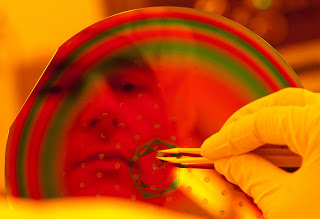Rice University physicists have created a tiny “electron superhighway” that could one day be useful for building a quantum computer, a new type of computer that will use quantum particles in place of the digital transistors found in today’s microchips.
They describe a new method for making a tiny device called a “quantum spin Hall topological insulator.” The device, which acts as an electron superhighway, is one of the building blocks needed to create quantum particles that store and manipulate data.
Arxiv – Evidence for Helical Edge Modes in Inverted InAs/GaSb Quantum Wells (4 pages)
Physical Review Letters – Evidence for Helical Edge Modes in Inverted InAs/GaSb Quantum Wells
CAPTION: In his quest to create a “topological insulator,” Rice graduate student Ivan Knez spent hundreds of hours modifying tiny pieces of semiconductors in Rice University’s clean room. CREDIT: Jeff Fitlow/Rice University
We present an experimental study of low temperature electronic transport in the hybridization gap of inverted InAs/GaSb composite quantum wells. An electrostatic gate is used to push the Fermi level into the gap regime, where the conductance as a function of sample length and width is measured. Our analysis shows strong evidence for the existence of helical edge modes proposed by Liu et al [ Phys. Rev. Lett. 100 236601 (2008)]. Edge modes persist in spite of sizable bulk conduction and show only a weak magnetic field dependence—a direct consequence of a gap opening away from the zone center.
The approach Du and Knez are following is called “topological quantum computing.” Topological designs are expected to be more fault-tolerant than other types of quantum computers because each qubit in a topological quantum computer will be made from a pair of quantum particles that have a virtually immutable shared identity. The catch to the topological approach is that physicists have yet to create or observe one of these stable pairs of particles, which are called “Majorana fermions” (pronounced MAH-yor-ah-na FUR-mee-ons).
The elusive Majorana fermions were first proposed in 1937, although the race to create them in a chip has just begun. In particular, physicists believe the particles can be made by marrying a two-dimensional topological insulator — like the one created by Du and Knez — to a superconductor.
Topological insulators are oddities; although electricity cannot flow through them, it can flow around their narrow outer edges. If a small square of a topological insulator is attached to a superconductor, Knez said, the elusive Majorana fermions are expected to appear precisely where the materials meet. If this proves true, the devices could potentially be used to generate qubits for quantum computing, he said.
Knez spent more than a year refining the techniques to create Rice’s topological insulator. The device is made from a commercial-grade semiconductor that’s commonly used in making night-vision goggles. Du said it is the first 2-D topological insulator made from a material that physicists already know how to attach to a superconductor.
“We are well-positioned for the next step,” Du said. “Meanwhile, only experiments can tell whether we can find Majorana fermions and whether they are good candidates for creating stable qubits.”
If you liked this article, please give it a quick review on ycombinator or StumbleUpon. Thanks

Brian Wang is a Futurist Thought Leader and a popular Science blogger with 1 million readers per month. His blog Nextbigfuture.com is ranked #1 Science News Blog. It covers many disruptive technology and trends including Space, Robotics, Artificial Intelligence, Medicine, Anti-aging Biotechnology, and Nanotechnology.
Known for identifying cutting edge technologies, he is currently a Co-Founder of a startup and fundraiser for high potential early-stage companies. He is the Head of Research for Allocations for deep technology investments and an Angel Investor at Space Angels.
A frequent speaker at corporations, he has been a TEDx speaker, a Singularity University speaker and guest at numerous interviews for radio and podcasts. He is open to public speaking and advising engagements.


